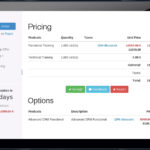Organizations have set profit objectives for managers. They must lead their teams in the right direction. Let’s look at some of the Leadership SMART Goals that enable managers to improve the overall effectiveness of their employees by tracking their progress.
There are countless effective resource management styles that bring success. Whatever type of manager you are, you are responsible for motivating and boosting the performance of your team. You’ll also need to optimize your own leadership abilities, which should be SMART goals for managers.
Setting goals entails developing a strategic plan and working together to achieve it. This means you’ll be setting goals for your team, individual members of your team, and yourself as a manager. Making the effort to clearly construct these goals before beginning work will ensure that your entire team is strategically aligned and working efficiently on what truly matters.
There are numerous explanations for why project plans do not go smoothly. However, in most cases, this is due to unclear project objectives. It is good to have the desired outcome in mind, but it will be impossible to achieve if the entire journey to that outcome is a mystery.
The answer is SMART goals. In this article, you will learn more about the SMART goals that you must set as a Manager.
What are SMART goals?
SMART goals are meant to assist you in constructing a more detailed project plan so that you can more precisely measure your success and make more accurate adjustments as needed.
The process emphasizes the importance of precision and metrics. Specific, Measurable, Achievable, Relevant, and Time-Bound are acronyms for the name.
Specific
This entails being crystal clear about what needs to be done. It may seem obvious, but this characteristic is frequently overlooked in goals, rendering them meaningless and ineffective. It is impossible to accomplish something that is vague or undefined.
Being specific entails answering the following key questions:
- What requirements must be met?
- Who is involved?
- Where exactly does the work get done?
- What are the work’s constraints?
This first approach involves removing uncertainty by fleshing out all of the details surrounding the goal.
Measurable
A clear metric for monitoring progress and evaluating when you will have met your goal. Measurable attributes specify how much you must achieve or improve.
If you don’t have any metrics to refer to for your project’s current status, determining whether to make changes will be difficult. Making the modifications becomes a massive headache.
eRS, a time tracking, and workforce management software is one of the best ways to measure these as well as your productivity.
Attainable
As a manager, it is best to set a challenging but achievable goal. Big dreams and pushing boundaries can benefit your team, but you must exercise caution when setting goals; they should not be unrealistic or preposterous.
If you set unattainable goals, your team members may experience frustration or repeated failures.
Setting an achievable goal requires taking available resources such as skills, time, and tools into account. Breaking down large goals into smaller ones can definitely help you get closer to your goal. With careful planning, you can use the resources at your disposal to help you achieve a goal for which you are currently prepared.
Relevant
An insignificant goal can cause chaos and confusion among your team members, as well as a sense that the larger goals will never be met.
A relevant goal is one that strikes a chord with you, your team, and your organization, and contributes to your cumulative and long-term leadership objectives.
Setting a SMART leadership goal is only advantageous if everyone is working toward the same goals. Setting SMART goals for managers should be done in conjunction with company-wide goals.
As a manager, aiding and abetting your employees in connecting their goals to company-wide goals will undoubtedly improve their performance.
Time-Bound
The letter T in SMART stands for having established start and end dates for a goal. It is the final yardstick for making your goal SMART.
Set your SMART goal in a timeframe that allows your goal to be achievable and easily tracked in terms of achievement while also keeping your team motivated.
A deadline keeps you on track and holds you and your team accountable. You can create a projected timeline with specific milestones to ensure that your team is always progressing toward a specific goal. This will show the rate at which your team is working and whether it needs to be changed.
Why are SMART goals important?
Being a leader involves a great deal of responsibility. You must boost team productivity by using the right productivity tools and setting goals that motivate them and are aligned with company-wide goals. Furthermore, no matter what type of leader you are, you must set goals for yourself and be constantly learning. Your teammates look up to you, so model the behaviors you want to see in them.
Setting SMART goals will ensure that you work efficiently on what is important and that your team is fully aligned.
What are the benefits of creating SMART goals for managers?
As a manager, you can set goals that align with your employees’ responsibilities in order to increase employee engagement and thus productivity in order to meet your company’s expectations.
Setting SMART Goals allows you to identify the short, medium, and long-term business objectives, establishing them in such a way that your team remains motivated, united, and ready to work on them.
1. Improve communication
Because projects involve many individuals, strong communication skills are essential. This is certainly relevant for remote teams, where communication breaks down so easily without face-to-face interaction.
Setting a communication goal may necessitate sitting down with the team and identifying what isn’t working. Listening to feedback helps you identify areas for improvement, whether it’s a new meeting agenda or better status reports.
SMART GOAL: The objective is to effectively communicate performance expectations to all team members during the upcoming project. Meeting this objective will increase project efficiency, eliminate rework, and allow us to meet the deadline.
2. Starting by removing Scope Creep
Scope-creep seems to be an inescapable occurrence in every project. There are always add-ons and adjustments, and the project manager has to write changes. Can it be completely eliminated?
SMART GOAL: The goal is to keep scope creep to a minimum by clearly outlining all project requirements during the planning phase. At weekly meetings, ensure that deliverables are made to specifications and show no signs of gold-plating. This goal aims to cut costs while also setting clear work expectations for the team.
3. Enhance teamwork
Teams that get along and support one another achieve better outcomes. However, forming a cohesive team is no easy task.
SMART GOAL: Over the project cycle, the goal is to improve team rapport in order to build trust, unleash potential, and boost productivity.
4. Maintain budget
This is a no-brainer; maintaining the budget should be at the top of any project manager’s list.
SMART GOAL: Maintain the project budget while delivering a product that meets all requirements.
Collaborate with the team to create a plan that makes the best use of resources and labor while staying within the budget. This goal seeks to conserve resources while increasing profits for the team.
5. Minimize project risk
Some project managers would rather deal with problems as they arise. Others have learned from experience that anticipating risks and issues saves time, money, and resources.
SMART GOAL: Create a risk and issue management plan for the upcoming project to save time and money and eliminate rework. During the planning meeting, identify all of the project’s assets, threats, and vulnerabilities, and devise a plan to avoid, transfer, accept, or mitigate each threat. Go over the plan again to identify any major upcoming threats or vulnerabilities.
Wrapping Up
Leadership entails significant responsibilities. From team commitment to role modeling, you can fuel your company’s success by honing your leadership skills and assisting employees in working toward common goals.
Managers who set clear goals for themselves and their teams improve employee and company performance.
The examples of leadership SMART goals provided in the blog can help you create your own SMART goals that focus on improving your leadership, communication, and other soft skills.
Moreover, our easy-to-use workforce management software comes with interactive scheduling features. eRS workforce management software facilitates the measurement and improvement of resource utilization. Exclusive features of eRS workforce management software include capacity reporting, a timesheet module, configurable working calendars, role-based access, and seamless third-party integration.








